Jimny roof load limit: a deep dive
This question gets asked almost as much as what tyres and lift to get when it comes to the Jimny.
The official answer is: 30 kg, including whatever hardware you put on the roof. That’s for the dynamics of driving, not the static absolute failure point of the roof which would be much higher.
The more long-winded version is below, where I both try to source as much info as I can about the roof load limit & also explain why it is what it is.
Sections
- Official sources
- Why would the roof load limit be 30 kg, anyway?
- What could happen if I exceed the roof load limit?
Official sources of roof load limits
Summary: the 30 kg load limit comes from the factory accessory roof racks, however, other roof rack accessory manufacturers follow this too albeit some with a nudge-nudge wink-wink approach.
First off, the roof load limit is mentioned in the various accessory catalogues for the JB74, e.g. this is the original print for the UK accesories brochure I was sent when looking at the car.
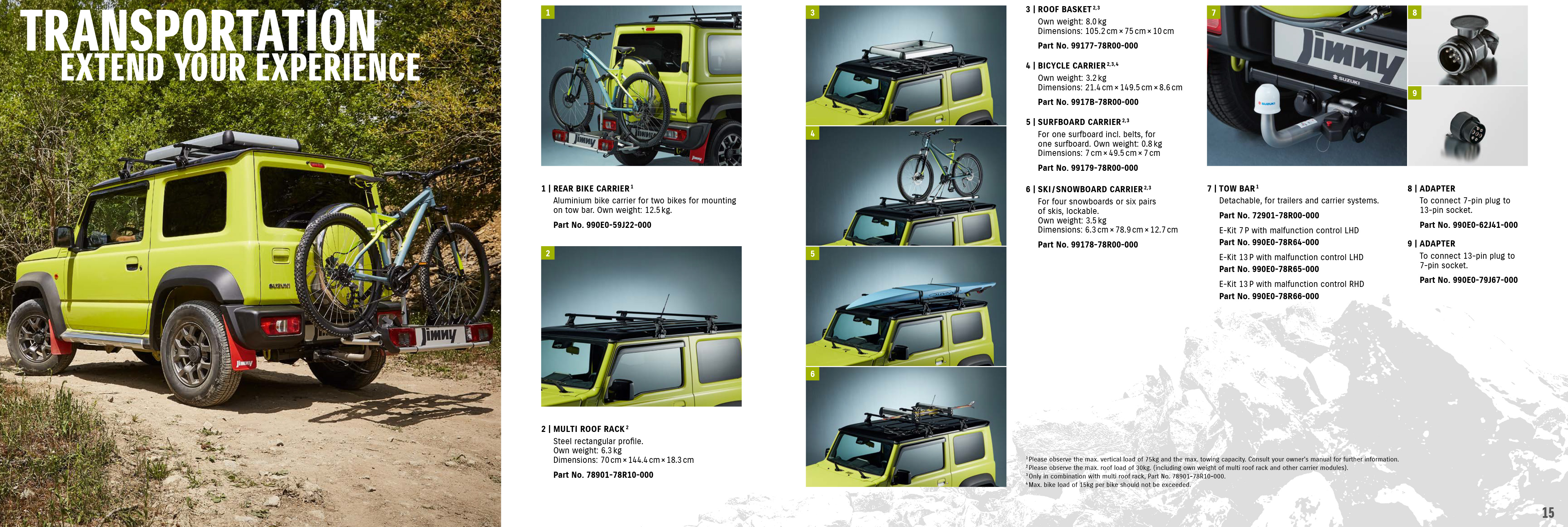
The key there is the footnote #2:
Please observe the max. roof load of 30kg. (including own weight of multi roof rack and other carrier modules).
Jimny Accessories Catalogue v1, © Suzuki UK
I also emailed Suzuki Australia early in 2023 to verify what they count as the roof load limit.
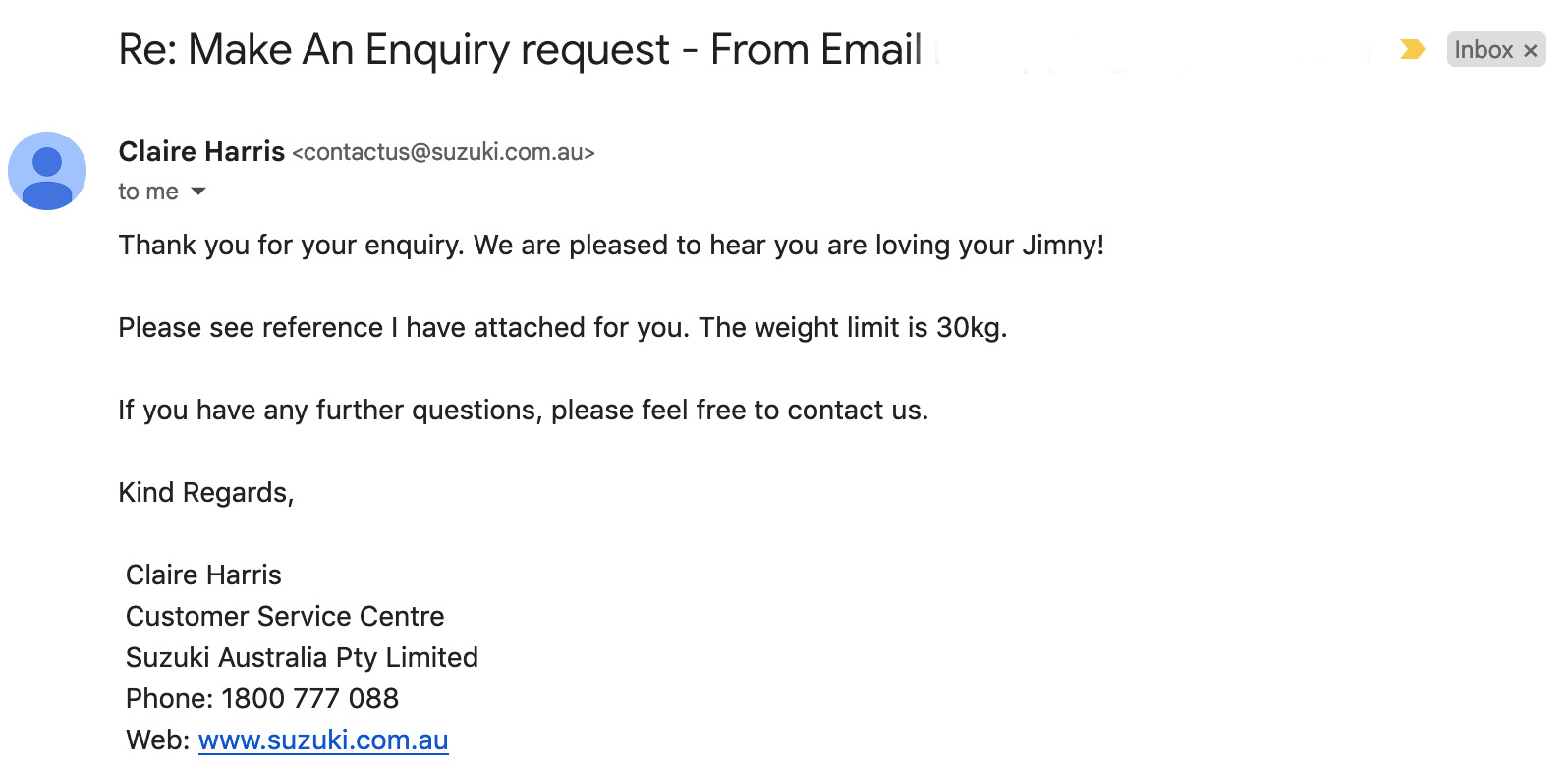
The reference attached to this is the PDF installation manual for the roof racks, which is available (as of time of writing of this) through the Global Suzuki accessories installation archive: https://www.globalsuzuki.com/after_sales/automobile/accessory_installation_manuals/data/pdf/78901-78R10-000_Multi_Roof_Rack.pdf
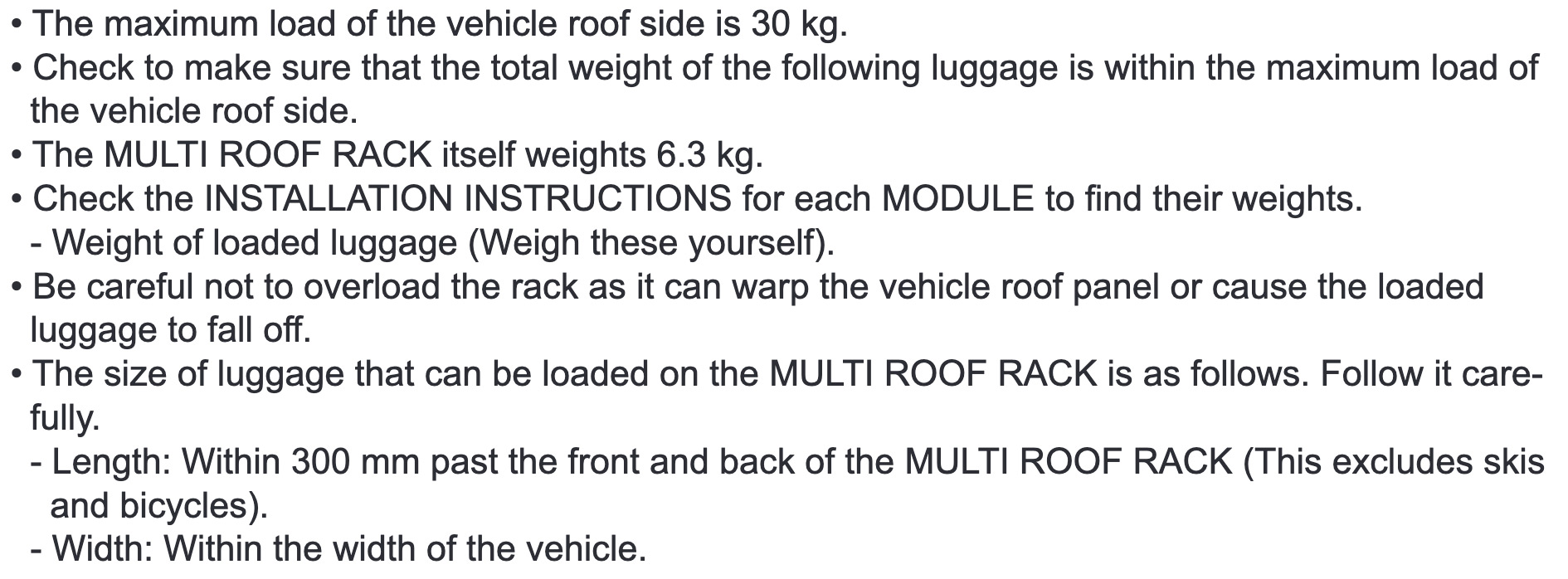
They’re the primary sources of info on it in terms of an official number.
So, 30 kg it is.
Aftermarket roof rack manufacturers generally fall back on the “enter the vehicle’s roof load limit” as step 1 of their individual ways to work out roof load limit, so they too would err on the side of the official Suzuki number of 30 kg. In general, the heavier the options a manufacturer provides the less they talk about the official roof load limit, though.
What about the 5 door Jimny XL JC74?
The 5 door uses the same roof racks as the 3 door and there’s no evidence that the roof load limit should be higher than the 3 door roof load limit. Indeed, the South African 5 door catalogue includes accessories and it includes the same disclaimer as the 3 door roof racks.
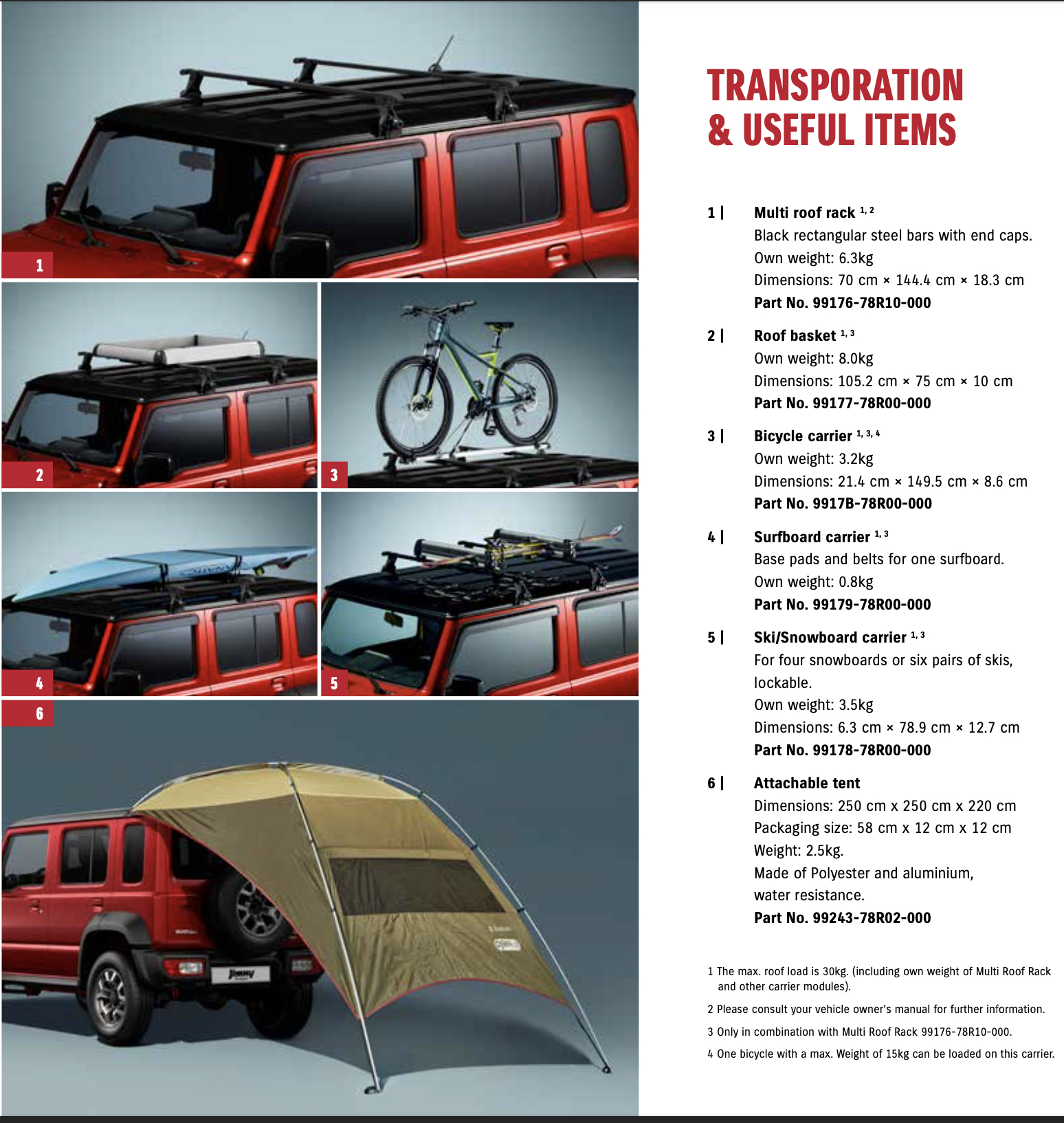
If you assume the roof load limit is a function of the maximum weight of the vehicle then the GVM goes from 1435 to 1545 kg, an increase of 7.7%. This would imply a roof load limit increase to 32.3 kg through simple linear scaling. If, on the other hand, you assume it’s down to the base weight of the car then it goes from 1075 to 1178 kg for the manual or 1090 to 1193 kg for the manual and auto respectively, increases of 9.4-9.6% or giving you up to 32.9 kg if you scale it up. Finally the wheelbase increases 340 mm from 2250 to 2590 mm, an increase of 15.1%. Even this only gets you to a max of 34.5 kg if you apply the logic that they’re proportional.
Ultimately I can’t see why Suzuki would increase the 5 doors roof load limit anything more than a miniscule amount and they’re much more likely to just keep it the same, as they appear to have done based on the South African brochure.
I did promise going deeper into this topic shortly, so let’s dive into some thoughts as to why the Jimny gets a 30 kg roof load limit. Before that, though…
Some popular roof rack brands and what they say (with official links)
Ultimately Suzuki do not specify a roof load limit in the owners manual for a reason they don’t publicly disclose. Without fitting roof crossbars or a roof rack then the limit is (technically) zero, however; it’s down to the specifics of the accessory you add to carry the weight.
| Brand / Model | Wording | Link to official source |
|---|---|---|
| Factory Suzuki crossbars | [p 13]: The maximum load of the vehicle roof side is 30 kg. | Official product installation manual |
| Front Runner: Slimline II Roof Rack | [p 4]: FRONT RUNNER RACK KITS OFTEN HAVE A HIGHER LOAD RATING THAN THE VEHICLES THEY ARE MOUNTED TO. PLEASE REFER TO YOUR SPECIFIC VEHICLE MANUFACTURER FOR A RECOMMENDED ROOF RATING. FRONT RUNNER CANNOT BE RESPONSIBLE FOR IMPROPER LOADING BEYOND THE VEHICLE MANUFACTURER’S STATED LOAD CAPACITY | Front Runner installation manual for roof rack (same wording as load bars have) |
| Front Runner: Load Bar Kit | [p 4]: FRONT RUNNER RACK KITS OFTEN HAVE A HIGHER LOAD RATING THAN THE VEHICLES THEY ARE MOUNTED TO. PLEASE REFER TO YOUR SPECIFIC VEHICLE MANUFACTURER FOR A RECOMMENDED ROOF RATING. FRONT RUNNER CANNOT BE RESPONSIBLE FOR IMPROPER LOADING BEYOND THE VEHICLE MANUFACTURER’S STATED LOAD CAPACITY | Front Runner installation manual for load bars (same wording as roof racks have) |
| ARB: Baserack (all sizes) | [p 403]: ARB BASE RACKS – Gutter Mount – 30kg Roof Load Rating | ARB Retail Price List, April 2024 |
| Thule Crossbars | [p 403]: 2dr With Rain Gutters 2019 on – Max Load 30kg | ARB Retail Price List, April 2024 (ARB distribute Thule products) |
| Rhino Crossbars: Heavy Duty or Vortex | [p 1]: Roof allowance 30 kg | Fitment supplement (Same fitment supplement for both types; note Rhino de-rate crossbars for offroad use) |
| Rhino: Jimny Overlander Platform | [p 4]: Load limit = up to 30 kg | ROLS1 fitment instructions |
| Prorack Crossbars | LOAD RATING 30 Kg (sic) | Prorack online specifications |
| Yakima TrimHD or Aero crossbars | Product Load Rating: 30 kg Please refer to the vehicle manufacturer specifications for max load capacity of vehicle. | Yakima specifications: TrimHD crossbars Yakima specifications: Aero crossbars |
| Eezi-Awn K9 Rack | [p 1]: 7. Lastly it is extremely important that your equipment including the weight of the K9 Rack does not exceed your vehicles maximum roof load specifications. 8. In order to obtain your vehicle specifications one would need to contact your vehicle manufacturer or distributor or look in your service book provided with your vehicle. | Eezi-Awn K9 Rak installation instructions for gen4 Jimny |
| Tracklander (fitting kit for all their racks/platforms) | Load Rating: Dependant on Tracklander roof rack size and vehicle’s roof loading from the vehicle manufacturer. | Tracklander gutter mount fitting kit specifications |
| Rola Sports Extended Roof Rack for Suzuki Jimny GJ | Roof Load Rating (kg): 30 | Roof rack product specifications page |
| Offroad Animal Scout roof rack | Vehicle roof rated to 30kg, and our rack weighs in at 23kg, so legally you can only carry 7kg of gear up there, however our Rack can hold 150kg with this system, so legally speaking what you put up there is up to you sorry. | Offroad Animal Scout roof rack product specifications |
| Ironman Atlas crossbars | Each cross bar has a dynamic load carrying capacity of 50kg. Please check with your vehicle manufacturer for vehicle specific roof load limits. | Ironman product specifications |
Note that there are some manufacturers, generally ones ex China or otherwise not meeting Australian standards, who claim a higher roof load limit but then usually weasel out with “but contact the vehicle manufacturer”. Suzuki Belgium are the only market who publish a higher than 30 kg roof load limit; and one European roof rack manufacturer claims a higher limit – but the tests passed are only around attachment points rather than stability testing. Even note that the couple that do specify a strength thing (e.g. 50 kg per crossbar for Ironman) they then say to contact the manufacturer from a total roof load capacity.
I have not included the couple of overseas options with the questionably justified load limits as I am writing from an Australian perspective. If their existence reassures you that you’re doing the right thing, however, then that’s entirely your call.
Ultimately: all either tell you 30 kg total roof load, or, refer to the manufacturer. As per my email exchange above the manufacturer will tell you 30 kg.
Let’s do that promised deep dive into why it might be 30 kg now, though.
Why would the roof load limit be 30 kg, anyway?
Stability
First and foremost, a vehicle with more weight up high has a higher centre of gravity. An object tips over if a line drawn straight down from the centre of gravity goes outside the track of the vehicle (suspension movements accounted for). With the Jimny having a high centre of gravity by virtue of its design, and a relatively narrow track width for a 4wd, load on the roof becomes much more critical to stability than for most 4wds.
As an example of the track width variation, and grabbing a 4wd wagon at random, a Y62 Nissan Patrol has a 1695 mm track width; a Jimny has a 1405 mm track width at the rear. That extra 20% track width helps a whole heap for stability. The Jimny’s CoG is probably not much different to a Patrol, so adding weight to the roof is gonna offset that. In addition, a Y62 Patrol with a 3500 kg GVM has 2.4x the total mass of a Jimny for the load to be a portion of. Couple those things together and the 30 kg Jimny roof load limit looks pretty proportional to the 100 kg for the Patrol.
I did a quick comparison of a few 4wd wagons available now. For the most part I’ve tried to stick to modernish things with ESP and stuff. There’s a reasonable correlation between GVM and roof load limit as depicted in this graph by a quick line of best fit.
(Update Jan 2024: I’ve added the GWM Tank 300 which people often say is a good cheap option to upgrade if you want to carry more stuff – note the factory rails on it are only rated to 40 kg; aftermarket options get you to 90 kg but this is still pretty inline with other wagons and their GVM vs. roof load limit).
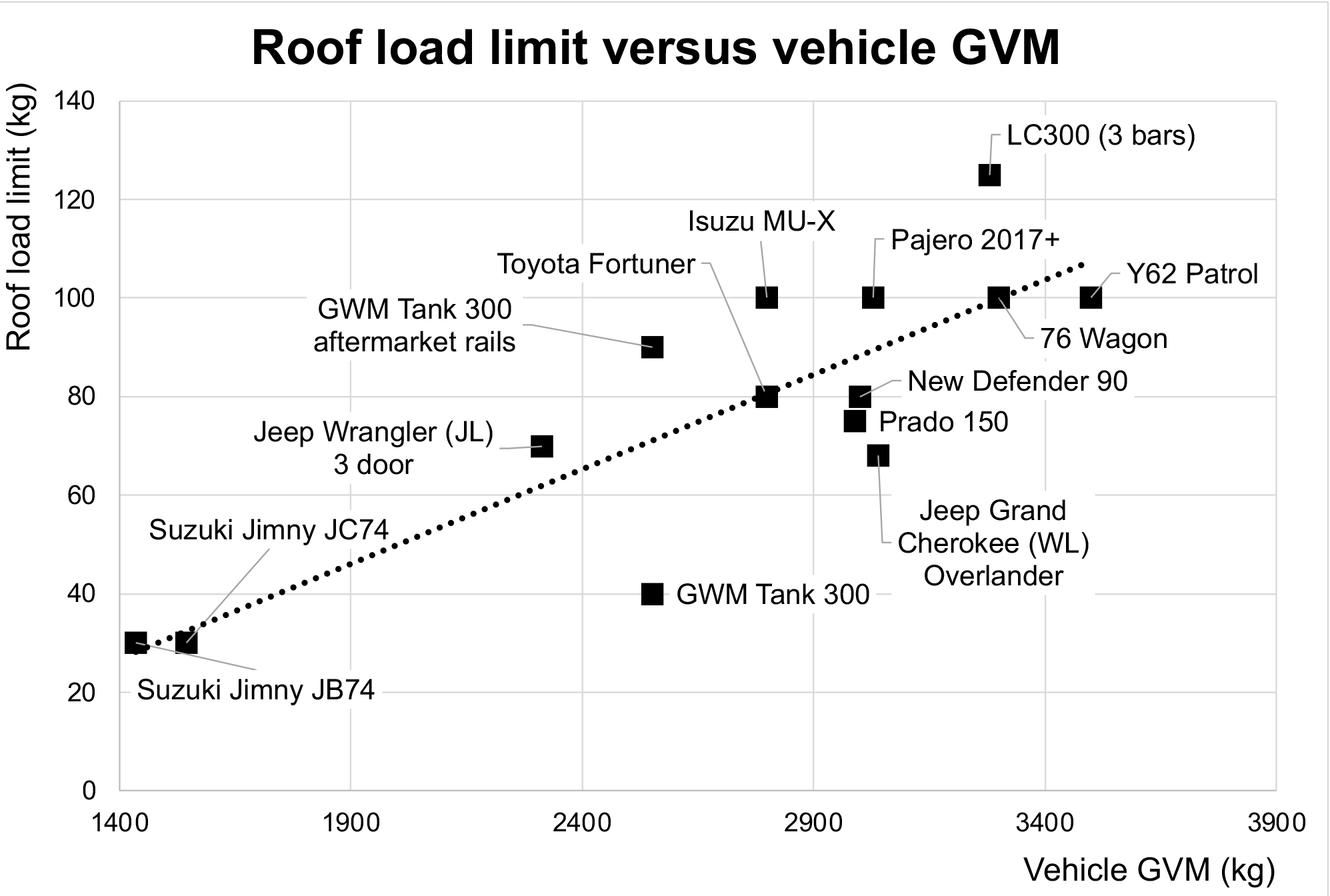
Ultimately, it looks like the Jimny’s roof load limit is because the rest of its weight is miniscule.
Note that the roof load limit set by Suzuki does not have any caveats with regards to offroad use – it’s 30 kg everywhere according to the documentation they provide. This means it’s a load limit that will let you use the car offroad how it is designed to be used, however, it will absolutely tip over more easily with more stuff on the road. For that reason I would be thinking long and hard about what I had on the roof offroad.
Forces at play, especially offroad
Corrugations in particular impart pretty big forces on a vehicle. Rather than going too deep into the maths, deep down in an article from Unsealed 4×4 they cover off on these forces. These can be 10x or more the total absolute failure point of a roof, so, you need to really think about those forces in rougher areas especially at speed. This again means you’re best off keeping weight as limited as possible on the roof, and is another reason why Suzuki would want to run a relatively low weight for their roof racks.
Forces offroad are why some roof rack manufacturers de-rate their load limits offroad. Rhino Rack do this, and are keen to reinforce their perspective after some high profile roof rack failures on HiLuxes. That’s down, in my eyes, to the attachment of how they went onto the roof of a HiLux as opposed to being a universal thing, more on this in a second. As noted in the sources above, Suzuki do not de-rate their factory bars for offroad use and Rhino have some products they absolutely do not de-rate offroad on the Jimny. Clearly the stability thing here matters a lot more than the strength argument in the case of a Jimny.
Strength of the roof & attachment points
A counter argument to the gen4/JB74 roof load limit being only 30 kg has been “well it was only that on a gen3/JB43 because they had plastic roof rails which failed”. True, but, consider this: the track width, CoG and overall vehicle weight are quite similar between the two generations. Engineering is not about overbuilding things but building things sufficiently. What if the roof rails on the gen3 were engineered to be good for 30 kg as a safe working load because that also happened to be the sensible limit? Engineering isn’t building a dam that won’t fall down, it’s about building a dam that just won’t fall down.
The gutter mounts used for various roof racks are probably good to higher weights: for instance the Rhino Vortex roof crossbars I use are the same legs as used on a bunch of 4wds which have roof load limits well beyond 30 kg. Clearly in this case the legs aren’t the weak point, but, that doesn’t change the stability of the vehicle especially in motion one bit.
Touching back on the HiLux thing earlier: the roof legs on the Vortex bars being good for a lot more than 30 kg does make me a bit more comfortable that they’ll probably not shake themselves apart or snap offroad. On the HiLux the attachment to the roof was using rivets; if the attachment was supported more from underneath then it wouldn’t have ripped out. That specific case was about installation trying to avoid something annoying (dropping the headliner to install the roof rack), rather than just strength per se.
Finally, let’s think about the static weight limit of the Jimny. The roof is clearly much stronger than 30 kg when the car is parked (assuming it’s not sideways on a slope, of course). Take, for instance, a rolled Jimny.

This car flipped off a transporter and landed on its roof. Even with the crushing forces of actually having to stop the vehicle’s weight, the 1100 kg or so of the car isn’t crushing the roof much at all. With the load spread out there’s no huge problem statically with weight on the car – it’s all about the dynamics of driving the car that matters.
I wouldn’t put 1100 kg on a roof platform, either, just for the record. If you’re in this article cause you’re worried about roof top tents there’s one thing I can reassure you of: if you are parked, and you have a suitably strong roof platform, you and another person and your pets are not going to crush a Jimnys roof.
I just wouldn’t drive it to where it’s parked, either, though…
What could happen if I exceed the roof load limit?
Note: for anything legal here I’m falling back on various Australian laws on this; your jurisdiction may well vary legality wise!
First off, there is no specific law that says ‘the roof load limit of x needs to be obeyed’. There are, however, related laws about loading thing. Each Australian state has something about a failure to secure a load correctly and this is often used when people use, say, incorrectly load rated ratchet straps even if the straps don’t fail. An argument could be made to apply this to overloading a roof. There are also various laws around operating your vehicle in a safe condition, a knowingly overloaded vehicle would potentially come under that.
In addition, there are specific weight limits you do have to abide by in Australia. Two key ones are:
- Gross vehicle mass (GVM): 1435 kg for a non upgraded Jimny, 1785 kg if you have the Ironman upgrade certified. (Queensland people can also upgrade to marginally higher GVMs, but that’s beyond the scope here).
- Front and rear axle load limits: 680 kg front, 880 kg rear for a non upgraded, car, 800 kg front, 1100 kg rear with the Ironman GVM upgrade.
Adding more than 30 kg to your roof, along with other things in your car, might well tip you over one or more of those 3 limits if you aren’t GVM upgraded. A 30 kg roof platform plus 30 kg up there is already getting close to 25% of your total load allowance and that’s before you account for yourself, gear in the car, other accessories fitted to the vehicle and even fuel beyond the tare mass 10L.
Beyond the legality side, there is also the question around insurance and having an accident. There is the potential that the insurance assessor might not look kindly on a crash involving a vehicle with a heavily loaded roof. This could be as simple as weighing what was on the roof in the case of a rollover and deeming you liable for overloading it beyond the manufacturers specification, but it potentially could extend as far as an argument that an incident was caused because you upset the vehicle dynamics by overloading it, and as a result the vehicle stability program has had to do things to keep the car from rolling over by intervening, and that’s caused you to run off the road or similar.
Specifically for a few key insurance company PDS the following applies:
Shannons and AAMI have the same wording:
THINGS WE DON’T COVER
Shannons and AAMI PDS statements, accessed 10 July 2023
You are not covered under any section of this policy for damage, loss, cost or legal liability that is caused by or arises from or involves:
…
Exceeding loading or passenger limits
your vehicle when it is:
…
carrying any load which is not secured according to law, over the legal limit or more than
what your vehicle was designed to carry.
Club4x4 do provide a slight out to their exclusion i.e. if you can show you having an overloaded roof didn’t contribute to your crash you’re still covered:
WHAT WE DO NOT COVER
Club4x4 PDS, accessed 10 July 2023
If you contributed to the loss or intended the claim to happen
You will not be covered under the policy for any loss, damage or legal liability if at the time of the event giving rise to the loss, damage or legal liability:
…
you were carrying more passengers or carrying or towing a load greater than your car was designed for, unless you can prove that this did not cause the accident. This includes bent or twisted chassis as a result of overloading your vehicle or towing a load greater than your car was designed for;
NRMA have an incredibly wordy PDS statement (and it varies by jurisdiction, but this is for SA, NT & WA). I’ve had to piece together but the relevant bit is:
General exclusions
NRMA PDS SA, NT, WA accessed 10 July 2023
You are not covered under any section of this Policy:
…
while Your Vehicle or a Substitute Vehicle:
…
– or anything Your Vehicle or a Substitute Vehicle is towing:
…
o exceeds the number of passengers or load limits
recommended by the manufacturer.
You may well get away with it, however, given how easily I was able to email Suzuki Australia and get an answer on the roof load limit then an assessor will also be able to do this.
It’s your car and I’m not here to tell you how to operate it, either, but hopefully this long-winded article has laid out some of the thinking behind it as well as provided some official sources with regards to the actual roof load limit of a gen 4/JB74/GJ Jimny.
As a parting word: I’m certainly not the roof top tent police, however, at least have a pretty good hard think about if it’s worth putting a 50-80 kg roof top tent. You and your partner and it will happily be safe and sound up in the tent once parked, but it’s a question of getting the vehicle to where you’re going with that load up there.
